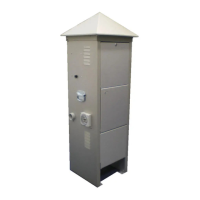Installation HiVol 3000 User manual 1.7
26
2.4.6 Filter Preparation
Note: When handling filter papers, clean laboratory
gloves should be worn. Only handle the extreme
edges of the filter papers.
1. Inspect each filter for defects such as loose material and discolouration.
Use a light table to check for pinholes and non-uniformity. Discard any
filters that are defective in any way.
2. Code each filter with a unique identification number. The number should
be lightly stamped on the underside of the filter on an outside corner.
Note: If the collected particulate matter is to be
chemically analysed, then a suitable number of
filters should be set aside as controls or blanks from
each batch of filters.
3. Filters must be equilibrated to conditions of the balance room for at least
24 hours before weighing.
Filter equilibration conditions for PM
10
(U.S. EPA Appendix J Part
50, AS/NZS 3580.9.6:2003).
The filter conditioning environment must be within the temperature range
of 15 to 30°C and controlled to within ± 3°C.
Similarily the humidity range of the conditioning environment must be
within the range of 20% to 45%* RH and controlled within ± 5% RH.
* AS/NZS 3580.9.6:2003 upper limit is 50% RH.
Re-weighing of exposed filters should be performed at similar
conditions of temperature and humidity as the initial weighing.
4. Prior to weighing filters an analytical balance with a sensitivity of 0.1mg
should be zeroed then checked using a standard weight (Class B working
mass, stainless steel or nickel chromium alloy or Class S weights of NBS
specification) of mass similar to the mass of the filter (nearest gram).
5. Weigh each filter to the nearest milligram. Record the weight and
identification number of each filter on the laboratory data sheet. Weighed
filters should be stored in a dust-proof container.
Note: Examine each exposed filter sample for
damage and for signs of air leakage.
Leakage around the seals may be identified by diffuse edges on the
boundary between the collected particulate matter and clean filter.
Leak-free seals produce a sharp well defined boundary. Small holes
in the filter will be characterised by a dark spot where the air has
preferentially flowed.

